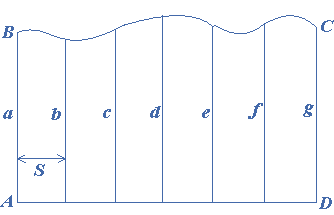Trapezoidal Rule
To find the area of the trapezium as shown in the figure, the base $$AD$$ is divided into equal intervals of width $$S$$. The ordinates $$a,b,c,d,e,f,g$$ are accurately measured. The approximation used in this rule is to assume that each strip is equal to the area of a trapezium. Therefore:
Area of a trapezium $$ = \frac{1}{2}$$ (sum of parallel sides) $$ \times $$ (perpendicular distance between the parallel sides)

Hence, the first strip’s approximate area is $$\frac{1}{2}\left( {a + b} \right)S$$
For the second strip, the approximate area is $$\frac{1}{2}\left( {c + d} \right)S$$, and so on.
Therefore, the approximate area of $$ABCD$$
$$ = \frac{1}{2}\left( {a + b} \right)S + \frac{1}{2}\left( {b + c} \right)S + \frac{1}{2}\left( {c + d} \right)S + \frac{1}{2}\left( {d + e} \right)S + \frac{1}{2}\left( {e + f} \right)S + \frac{1}{2}\left( {f + g} \right)S$$
$$ = S\left( {\frac{{a + b}}{2} + \frac{{b + c}}{2} + \frac{{c + d}}{2} + \frac{{d + e}}{2} + \frac{{e + f}}{2} + \frac{{f + g}}{2}} \right)$$
$$ = S\left( {\frac{a}{2} + b + c + d + e + f + \frac{g}{2}} \right) = S\left( {\frac{{a + g}}{2} + b + c + d + e + f} \right)$$
Area $$ = $$ $$($$width of interval$$)$$ $$[$$sum of first and last ordinate $$/2$$ + sum of remaining ordinates$$]$$
Example:
Find the area of a cross-section of a river along a line where the depths at equal intervals of $$10$$m are noted as $$0,7,11,15,5,0$$m, respectively.
Solution:
Width of each strip, $$S = 10$$m
Ordinates are $$ = 0,7,11,15,5,0$$
Since,
Area $$ = $$ $$($$width of interval$$)$$ $$[$$sum of first and last ordinate $$/2$$ + sum of remaining ordinates$$]$$
$$ = 10\left[ {\frac{{0 + 0}}{2} + 7 + 11 + 15 + 5} \right] = 10 \times 38 = 380$$ square meters.
Example:
Apply the trapezoidal rule to find the area of a plot of land having the following dimensions:
Ordinates: $$2,7,18,38$$ and $$70$$m
Common distance: $$33$$m
Solution:
Given that $$a = 2$$m, $$b = 7$$m, $$c = 18$$m, $$d = 38$$m, $$e = 70$$m respectively and $$S = 33$$m
$$\therefore $$ by the trapezoidal rule:
Area $$ = S\left[ {\frac{{a + e}}{2} + \left( {b + c + d} \right)} \right]$$
$$ = 33\left[ {\frac{{2 + 70}}{2} + \left( {7 + 18 + 38} \right)} \right]$$
$$ = 33\left[ {36 + 63} \right] = 33\left( {99} \right) = 3102$$ square meters.
